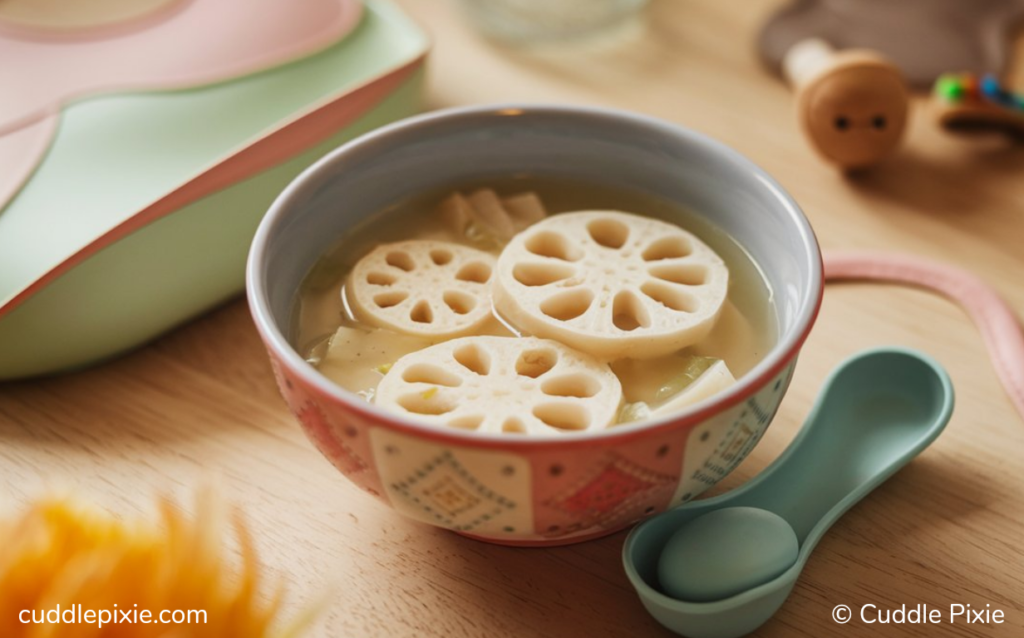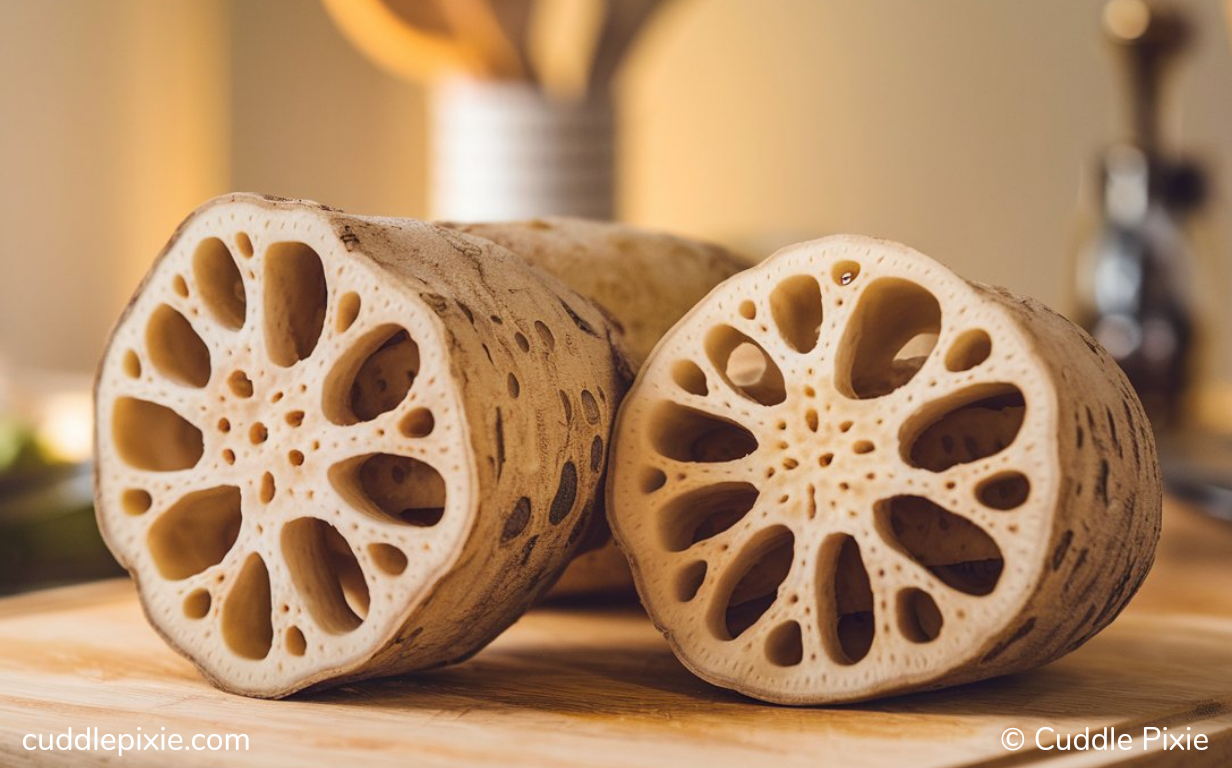Lotus root is not just a culinary delight; it is also a nutritional powerhouse that can significantly benefit your baby’s diet. This versatile vegetable is renowned for its unique texture and health benefits, making it an excellent choice for introducing new flavors to your little one. In this article, we will explore the myriad benefits of lotus root for babies, how to prepare it safely, expert opinions, and simple recipes to make this nutritious food a staple in your child’s diet.
In This Article
Understanding Lotus Root
Lotus root, or Nelumbo nucifera, is the underwater rhizome of the lotus plant. It has a crunchy texture and a mildly sweet flavor, making it a popular ingredient in various cuisines, particularly in Asian dishes. The root can be found in various forms—fresh, dried, pickled, or canned. Rich in nutrients, lotus root is a remarkable addition to any baby’s diet.
Nutritional Profile
Before diving into the benefits, let’s examine the nutritional value of lotus root. A 100-gram serving typically contains:
- Calories: 74
- Carbohydrates: 17 grams
- Fiber: 7 grams
- Protein: 2 grams
- Fat: 0.1 grams
- Vitamin C: 44% of the Daily Value (DV)
- Iron: 10% of the DV
- B-Vitamins: Includes B1 (Thiamine), B2 (Riboflavin), and B3 (Niacin)
The combination of fiber, vitamins, and minerals makes lotus root an excellent choice for infants transitioning to solid foods.
Health Benefits of Lotus Root for Babies

1. Promotes Digestive Health
One of the most significant benefits of lotus root is its high fiber content. Fiber aids digestion and helps prevent constipation, a common issue for infants transitioning to solid foods.
“When properly prepared, lotus root can support a baby’s developing palate and provide essential nutrients for growth,” suggested Dr. Michael Patel, child nutrition specialist.
2. Strengthens Immune Function
Lotus root is rich in vitamin C, a powerful antioxidant that boosts the immune system. This nutrient helps the body fight off infections, making it crucial for growing infants.
“The nutritional profile of lotus root, with its fiber, vitamin C, and B-vitamins, makes it a great choice for introducing variety into a baby’s diet,” said Sarah Johnson, registered dietitian.
3. Supports Cognitive Development
The iron content in lotus root is vital for brain development. Iron is essential for the production of hemoglobin, which carries oxygen to the brain.
“Lotus root is rich in iron, which is crucial for babies’ cognitive development. Just ensure it’s cooked until very soft for easy digestion,” explained Amanda Wu, pediatric nutritionist.
4. Enhances Bone Health
Lotus root contains calcium, which is essential for developing strong bones and teeth. This is especially important in the early years when rapid growth occurs.
5. Reduces Inflammation
Lotus root has anti-inflammatory properties, which can help soothe digestive issues and promote overall health in babies.
6. Provides Energy
The carbohydrates found in lotus root serve as an energy source, helping babies stay active and engaged in their surroundings.
When and How to Introduce Lotus Root to Your Baby
Timing for Introduction
You can introduce lotus root to your baby’s diet around 6 months of age, which is the typical age for starting solids. At this stage, babies can begin to explore a variety of flavors and textures, making it the perfect time to include lotus root.
“Lotus root can be a wonderful addition to a baby’s diet after 6 months. Its unique texture and mild flavor make it an interesting food for little ones to explore,” explained Dr. Emily Chen, pediatrician.
Preparation Tips
- Choose Fresh Lotus Root: Look for firm, smooth roots without any blemishes or soft spots.
- Thoroughly Wash: Clean the lotus root under running water to remove any dirt or contaminants.
- Peel and Slice: Peel the outer skin using a vegetable peeler and slice it into thin pieces or rounds.
- Cooking Method: Boil, steam, or stir-fry the slices until they are soft. Avoid frying, as this may introduce unhealthy fats.
- Texture Adaptation: Depending on your baby’s age and ability to chew, serve lotus root as a puree, mashed, or cut into small, manageable pieces.
Safety Precautions
While lotus root is generally safe for babies, there are some important safety precautions to keep in mind:
- Allergy Watch: Always monitor for any signs of allergic reactions when introducing a new food. Symptoms may include rashes, stomach upset, or unusual irritability.
- Choking Hazard: Ensure the lotus root is cooked until very soft to avoid choking hazards. Serve it in appropriate textures based on your baby’s developmental stage.
“When preparing lotus root for babies, thorough washing and cooking are essential to eliminate any potential contaminants and ensure it’s safe for consumption,” warned Tom Anderson, food safety expert.
Preventing Picky Eating with Lotus Root
Introducing a variety of flavors and textures at an early age can help prevent picky eating habits later on. Lotus root, with its unique crunch and mild flavor, can be an exciting addition to your baby’s diet.
“Introducing foods like lotus root early on can help prevent picky eating later. It’s all about exposing babies to diverse flavors and textures,” advised Lisa Rodriguez, parenting coach.
By incorporating lotus root into meals and offering it alongside other vegetables, you can help your child develop a love for diverse foods.
Simple Lotus Root Recipes for Babies

1. Lotus Root Puree
Ingredients:
- 1 lotus root, peeled and sliced
- Water
Instructions:
- Boil the lotus root slices in water until they are soft (approximately 15-20 minutes).
- Drain and transfer the cooked lotus root to a blender.
- Add a little water if necessary to achieve the desired consistency and blend until smooth.
This simple puree can be served as a standalone dish or mixed with other pureed vegetables for added nutrition.
2. Lotus Root and Vegetable Mash
Ingredients:
- 1 lotus root, peeled and diced
- 1 small carrot, peeled and diced
- 1 potato, peeled and diced
- Water or vegetable broth
Instructions:
- Boil all the ingredients in water or vegetable broth until soft (about 20-25 minutes).
- Drain and mash with a fork or potato masher, adding liquid to reach the desired consistency.
This mash provides a balanced meal packed with nutrients.
3. Lotus Root and Chicken Soup
Ingredients:
- 1 lotus root, sliced
- 1 small chicken breast, diced
- 2 cups chicken broth
- 1 carrot, diced
Instructions:
- In a pot, combine all ingredients and bring to a boil.
- Reduce heat and let simmer for 30 minutes until the chicken is cooked through and the lotus root is tender.
- Allow it to cool slightly before serving to your baby.
This nutritious soup is a great way to incorporate protein and flavor.
4. Lotus Root Finger Food
For older babies who are ready for finger foods, you can prepare roasted lotus root slices.
Ingredients:
- 1 lotus root, peeled and sliced
- Olive oil
- A pinch of salt (optional)
Instructions:
- Preheat the oven to 400°F (200°C).
- Toss lotus root slices in a little olive oil and arrange them on a baking sheet.
- Roast for about 20-25 minutes or until they are golden and crispy.
These roasted slices make a delightful finger food that babies can enjoy while exploring textures.
Developmental Benefits: Oral Motor Skills
The unique texture of cooked lotus root can aid in developing your baby’s oral motor skills. As they learn to chew and swallow different consistencies, foods like lotus root can help enhance these skills.
“The unique texture of cooked lotus root can help in developing a baby’s oral motor skills as they learn to chew and swallow different consistencies,” noted Dr. Olivia Thompson, developmental pediatrician.
Encouraging babies to explore various textures prepares them for a more diverse diet as they grow.
Cultural Significance of Lotus Root
In many Asian cultures, lotus root is revered not just for its taste but also for its health benefits. It is often featured in festive dishes and considered a “cooling” food, especially during hot months.
“In many cultures, lotus root is considered a ‘cooling’ food. It can be a soothing addition to a baby’s diet, especially during warmer months,” said Maria Sanchez, holistic nutritionist.
The incorporation of lotus root into your baby’s diet can offer cultural diversity, introducing them to flavors and foods that have historical significance.
Final Thoughts
Lotus root is a nutrient-dense, versatile vegetable that can greatly enhance your baby’s diet. With its impressive nutritional profile and various health benefits, it’s an excellent choice for parents looking to introduce new flavors and textures. By preparing it properly and monitoring your baby’s reactions, you can make lotus root a regular part of their meals.
Remember to consult with your pediatrician before introducing any new foods, especially if your baby has existing dietary restrictions or allergies. With the right approach, lotus root can be a delightful addition to your baby’s culinary journey, providing not just nutrition but also fostering a love for diverse foods that will benefit them for years to come.
